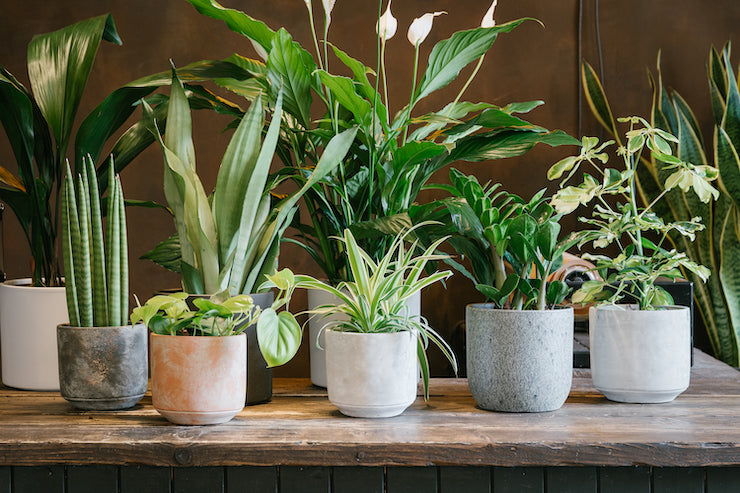
How to water houseplants
The title ‘How to water houseplants’ may seem obvious, however some of our most asked questions revolve around watering your indoor plants. Whether that be understanding watering schedules, solving plant problems or the best technique for adding water - this deep dive into watering should help you better understand your houseplants needs.
Different plants have different watering schedules
The most important thing to remember when figuring out watering schedules is understanding each plant's native environment. All of the plants we sell come with care tags to ensure you have this information easily accessible! However, a search on Google will give you a general idea of the natural environment your plants inhabit. The main habitats are rainforests, deserts, swamps, aquatic and epiphytic. Broadening your knowledge will help you understand how plants have evolved to live in these environments.
Most leafy houseplants are found in tropical rainforests which means that they are used to high humidity and tend to require watering when the top inch of compost has dried out.
Cacti and succulent plants have adapted to their desert environments by storing water in their leaves and stems. This allows them to survive periods of drought and is why they require very little watering. However, don’t assume all cacti live in the desert as some varieties such as Rhipsalis, Epiphyllum and Lepismium bolivianum come from tropical rainforests and therefore thrive in higher humidity.
Epiphytic plants are plants that grow on the trunks of trees. They generally require very little watering as they gain most of their moisture from humidity, and occasional rainfall.
Some plants such as carnivorous plants or the Syngonanthus ‘Mikado’ have adapted their root systems to survive damp, swampy conditions. This means that these plants prefer to be kept moist in the warmer weather and should never be allowed to dry out.
Aquatic plants such as Marimo Moss Balls Cladophora aegagropila live in freshwater lakes and therefore prefer to live in distilled water in our homes. Remember that a jar of water does not contain all of the elements to create healthy ecosystems so water must be changed every 2 weeks to offer oxygen to the plant. Different aquatic plants vary in care so always check our care labels to understand their requirements.
Hydroculture plants are a little different as these plants naturally grow in compost, however have been adapted by growers to grow in a vessel with a reservoir. Water should only be added when the reservoir levels are low.
How do I know if my plant is ready to be watered?
The most effective way of checking if a plant requires watering is by sticking your finger into the compost! General houseplants tend to prefer the top inch to two inches of compost to dry out between waterings. Cacti and succulents like the soil to have completely dried out. Weight is also an excellent way of checking if the compost has dried out - the lighter the pot, the drier the compost.
Season and temperature also need to be considered and watering schedules should be adapted accordingly as cooler temperatures mean the compost will not dry out as quickly as in the summer months. Our Soil Moisture Meter is a great tool for checking if your plants need watered. Simply insert the meter to the base of the pot and water according to the moisture level.
What tools do I need for plant watering?
There are a couple of techniques you can use to water your plants. The most common choice is to water from above using a watering can. We recommend watering cans by Haws. Haws is one of the world’s first watering can manufacturers and to this day they are still creating durable, stylish vessels perfect for indoor and outdoor use. When adding water ensure to remove your plant from its decorative pot. Hold it over the sink and add water until it begins to drain out of the drainage holes at the base of the plastic pot. Once drained, place the plant back in its usual spot. For bushy succulents who hate getting their leaves wet we recommend watering from below. Simply fill the sink or a tray with water and sit your plant in it for approximately half an hour to allow the roots to soak up water.
For those who are more forgetful, or are often away from home, watering globes are a great option to keep your plants hydrated. We recommend Waterworks Watering Globes for trips that last as long as one month, or Ollas by Pepin which need refilled around once a week. These vessels are perfect for larger plants and are designed to slowly release water through their terracotta tips to ensure your plants survive periods of drought.
Plantstraws is another stylish self-watering solution and has recently made it to the New York Times list of best gifts for plant lovers of 2024. Simply place one end of the plant straw into the plants compost and the other end into a vessel of water. The Plantstraw will slowly pull water from the glass and into the compost.
Why are the leaves on my plant going yellow?
There a couple of clear signs houseplants have been overwatered and yellowing leaves is the most common signal. This occurs due to rot within the plant’s root system. Soft black splodges begin on the roots, and this can eventually turn them brown and mushy. As the root rot worsens, stems can also begin to turn mushy. Depending on how much the plant has rotted, there may even be a distinct smell coming from your houseplant!
Root rot is caused when the roots of the plant become waterlogged and can no longer take in oxygen or nutrients. If not resolved this will sadly cause the plant to die. Overwatering is usually caused if the soil has not been allowed to dry out enough between waterings, this is particularly likely during the autumn/winter when temperatures are cooler. Overwatering can also be caused if your plant is potted into a pot with no drainage, meaning that excess water will collect at the base of the pot where the roots sit. This will cause the roots to rot.
If your plant is suffering because of overwatering, remove the plastic pot to check the roots. Healthy roots will be white and firm, whilst rotten roots will appear brown and mushy. Remove the mushy roots with clean, sharp scissors. Place the plant back in its pot, refreshing some of the compost, and move to a warm, bright spot in your home. Then, allow the plant to dry out almost completely before you next water it. Going forward, watering schedules will need to be adapted to ensure the compost is sufficiently dry between waterings.
For more plant care accessories and care information check out our website, or head in to one of our stores where our Plant Gurus are on hand for any plant enquiries!



